Lazare Hoche
Louis Lazare Hoche ([lwi la.zaʁ ɔʃ]; 24 June 1768 – 19 September 1797) was a French soldier who rose to be general of the Revolutionary army. He won a victory over Royalist forces in Brittany. His surname is one of the names inscribed under the Arc de Triomphe, on Column 3. Richard Holmes says he was "quick-thinking, stern, and ruthless...a general of real talent whose early death was a loss to France."[1] A famous statement of general Hoche: "Facta, non verba" ("acts, no words")[2]
Louis Lazare Hoche | |
|---|---|
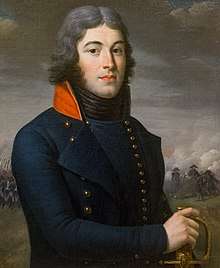 General Hoche | |
| Born | 24 June 1768 Versailles, France |
| Died | 19 September 1797 (age 29) Wetzlar, Holy Roman Empire |
| Allegiance | |
| Service/ | Infantry |
| Years of service | 1784–1797 |
| Rank | Général de division |
| Commands held | Armée de la Moselle Armée des côtes de Brest Armée des côtes de Cherbourg Armée de Sambre-et-Meuse |
| Battles/wars | French Revolutionary Wars Expédition d'Irlande War in the Vendée Chouannerie |
| Awards | Names inscribed under the Arc de Triomphe |
| Other work | Minister of War |
| Signature | |
Early life
Born to poor parents near Versailles, he enlisted at sixteen as a private soldier in the Gardes Françaises. He spent his entire leisure in earning extra pay by civil work, his object being to provide himself with books, and this love of study, which was combined with a strong sense of duty and personal courage, soon led to his promotion.
Revolutionary army career
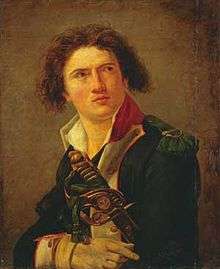
When the Gardes françaises disbanded in 1789 he had reached the rank of corporal, and thereafter he served in various line regiments up to the time of his receiving a commission in 1792. In the defence of Thionville in that year Hoche earned further promotion, and he served with credit in the operations of 1792–1793 on the northern frontier of France, including serving as aide-de-camp to General le Veneur. When Charles Dumouriez deserted to the Austrians, Hoche, along with le Veneur and others, fell under suspicion of treason. However, after being kept under arrest and unemployed for some months, he took part in the defence of Dunkirk, and in the same year (1793) he was promoted successively chef de brigade, général de brigade, and général de division. In October 1793 he was provisionally appointed to command the Army of the Moselle, and within a few weeks he was in the field at the head of his army in Lorraine. He lost his first battle at Kaiserslautern during 28–30 November 1793 against the Prussians, but even in the midst of the Reign of Terror the Committee of Public Safety retained Hoche in his command. In their eyes, pertinacity and fiery energy outweighed everything else, and Hoche soon showed that he possessed these qualities.
On 22 December 1793 he won the Battle of Froeschwiller, and the representatives of the National Convention with his army at once added the Army of the Rhine to his sphere of command. In the Second Battle of Wissembourg on 26 December 1793, the French drove Dagobert Sigmund von Wurmser's Austrian army from Alsace. Hoche pursued his success, sweeping the enemy before him to the middle Rhine in four days. He then put his troops into winter quarters.
Arrest
Before the following campaign opened, he married Anne Adelaide Dechaux at Thionville (11 March 1794). But ten days later he was suddenly arrested, charges of treason having been proferred by Charles Pichegru, the displaced commander of the Army of the Rhine, and by his friends. Hoche escaped execution, but was imprisoned in Paris until the fall of Maximilien Robespierre.
War in the Vendée
Shortly after his release he was appointed to command against the Vendéans (21 August 1794). He completed the work of his predecessors in a few months by the Treaty of La Jaunaye (15 February 1795), but soon afterward the war was renewed by the Royalists. Hoche showed himself equal to the crisis and inflicted a crushing blow on the Royalist cause by defeating and capturing de Sombreuil's expedition at Quiberon and Penthièvre (16–21 July 1795). Thereafter, by means of mobile columns (which he kept under good discipline), he succeeded before the summer of 1796 in pacifying the whole of the west, which had for more than three years been the scene of a pitiless civil war.
Ireland and Austria
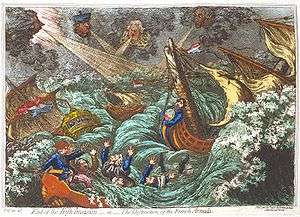
Following this, Hoche was appointed to organise and command the Ireland Expedition, of troops sent to assist the United Irishmen in their rebellion against British rule. A tempest, however, separated Hoche from the expedition, and after various adventures the whole fleet returned to Brest without having effected its purpose.
Hoche was at once transferred to the Rhine frontier, where he defeated the Austrians at the Battle of Neuwied in April 1797, though operations were soon afterwards brought to an end by the Preliminaries of Leoben.
Later career and death
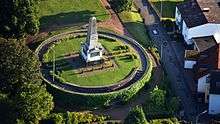
Later in 1797 Hoche was minister of war for a short period, but in this position he was surrounded by obscure political intrigues, and, finding himself the dupe of Paul Barras and technically guilty of violating the constitution, he quickly laid down his office, returning to his command on the Rhine frontier. It was his denunciation during that time that had led to Kléber's removal from command. The compromising letter was found by Jean Baptiste Alexandre Strolz in Hoche's papers.[3][4]
Hoche's health grew rapidly worse, and he died at Wetzlar on 19 September 1797 of consumption (tuberculosis). The belief spread that he had been poisoned, but the suspicion seems to have had no foundation. He first was buried next to his friend François Marceau in a fort at Koblenz on the Rhine. In 1919, the French Rhine army buried his mortal remains into the 1797-built Monument General Hoche in Weißenthurm near Neuwied, where he had started his last campaign against the Austrians.
Memorials
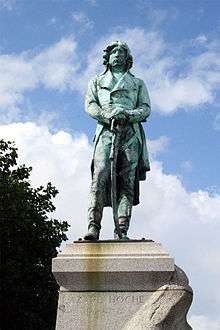
He is commemorated by a statue in Place Hoche, a gardened square not far from the main entrance to the Palace of Versailles, and another in the Panthéon. Another statue, the last major work by Jules Dalou, is in Quiberon, Brittany. In Les Invalides where Napoleon's tomb is enshrined, there is also a memorial to Hoche. A station on the Paris Metro is also called 'Hoche'.
Hoche's motto was Res non-verba, which is Latin for "Deeds, not words".
In popular culture
- Brown, Leah Marie, Silence in the Mist: A Novel of the French Revolution, Eternal Press, 2011
Notes
- Richard Holmes, ed. The Oxford companion to military history (2001) p 411.
- D.J.A. Westerhuis (1957) Prisma Latijns Citatenboek
- Librairie R. Roger et F. Chernoviz, Feuilles d'Histoire du XVII au XX Siècle, Tome 6, Paris 1911, p. 332
- Lubert d' Héricourt: La Vie du Général Kléber, Paris 1801, p.122
References
- Clerget, Charles (1905). Tableaux des Armées Françaises pendant les Guerres de la Révolution. Paris: Librarie Militaire R. Chapelot et Cie. Retrieved 3 July 2015.CS1 maint: ref=harv (link)
- Tishkoff, Doris, Empire of Beauty, New Haven, 2011.

External links

| Military offices | ||
|---|---|---|
| Preceded by Jacques Charles René Delaunay |
Commander-in-chief of the Army of the Moselle 31 October 1793 – 18 March 1794 |
Succeeded by Jean-Baptiste Jourdan |
| Preceded by Pierre Vialle |
Commander-in-chief of the Army of the Coasts of Cherbourg 1 September 1794 – 30 April 1795 |
Succeeded by Jean-Baptiste Annibal Aubert du Bayet |
| Preceded by Thomas-Alexandre Dumas |
Commander-in-chief of the Army of the Coasts of Brest 10 November 1794 – 10 September 1795 |
Succeeded by Gabriel Venance Rey |
| Preceded by Jean Baptiste Camille Canclaux |
Commander-in-chief of the Army of the West 11 September – 17 December 1795 |
Succeeded by Amédée Willot |
| Preceded by New organization |
Commander-in-chief of the Army of the Coasts of the Ocean 5 January – 22 September 1796 |
Succeeded by Discontinued |
| Preceded by New organization |
Commander-in-chief of the Army of Ireland 1 November – 23 December 1796 |
Succeeded by Emmanuel Grouchy |
| Preceded by Emmanuel Grouchy |
Commander-in-chief of the Army of Ireland 19 January – 9 February 1797 |
Succeeded by Discontinued |
| Preceded by Jean Victor Marie Moreau |
Commander-in-chief of the Army of Sambre-et-Meuse 9 February – 18 September 1797 |
Succeeded by François Joseph Lefebvre |
| Political offices | ||
| Preceded by Claude Louis Petiet |
French minister of War 15 July 1797 – 22 July 1797 |
Succeeded by Barthélemy Louis Joseph Schérer |
._D%C3%A9claration_des_Droits_et_des_Devoirs_de_l'Homme_et_du_Citoyen.jpg)